Grandmasters from the past
The world famous Brothers Janssen from Arendonk
Brothers Janssen from Arendonk…a name where people still speak about within pigeon sport with a lot of reverence. The Brothers Janssen found themselves between the big ambassadors who carried out Belgian pigeon sport over the entire world.
How many fanciers from all over the world went, over all the years, through the white little gate at the Schoolstraat 6 in Arendonk to meet the famous brothers and/or went to get something from their unbeatable pigeons. How many didn’t leave with a small pigeon from only 10 days old to build up an entire colony. Despite their success they have always been very sympathetic and honest people and they lived all together as one family in all simplicity and alone for their pigeons. It is certainly not easy to write a short story about these celebrities out of a very rich pigeon history. We tried to give you in this short story an impression about who the brothers Janssens were, how they lived and which pigeons took care of the world successes. I give thanks to Ad Schaerlaeckens, who gave his permission to use his impressive book work “Gebroeders Janssen uit Arendonk, beroemdste duivenliefhebbers aller tijden” and a few pictures as lead for this story.
The beginning of the glorious pigeon family Janssen
The history of the glorious pigeon family Janssen from Arendonk started in fact in 1886 when Henri Janssen, called ‘Driek (ske) popularly and born in 1872, became a member of the ‘gild of the pigeon fanciers’. Since he was a young lad he was possessed by pigeons and when he was only 14 years old he already had pigeons at the attic in the Begijnhof. He was known then as ‘Driekske den Pauw’.
Arendonk didn’t have a pigeon club in that period and they needed to go to Oud-Turnhout to basket. Together with some fanciers out of Arendonk they were the founders in 1913 from a local pigeon club ‘De Snelle Duif’ which still exists today. During the period of 1908 until 1914 Driekske had very good pigeons with amongst them a hen ‘Het Blauwke’ who won 20 1st prizes on the short distance races. During that period he also won a few head prizes like a few bikes. He married Pauline and they became parents to nine children namely Frans, Fons, Jef, Vic, Irma, Adriaan, Charel, Marie and Louis. All the children were born between 1895 and 1913. Henri was also a fervent canary breeder and from canary breeders is known that they don’t like to breed too much very close within the same family to keep the colour- or sing quality of their birds.
Henri and his sons kept in means of family breeding and in not a too close connection, with the care built up strain pigeons together and only once in a while something were added. When one would make up the pedigrees of the pigeons from back then one would certainly find a clear connection amongst them. Henri was a quiet person who loved nature and everything that had to do with pigeons had also something to do with nature. Like for example he never did a winter breeding or raced pigeons on widowhood. With a lot of patience, observation, knowledge and tremendously lots of love for pigeons he built up with the help of his family his own strain of pigeons that almost never met their equals. In the twenties also the sons started to keep busy intensively with pigeon sport and until the death of Henri in September 1949 they practised pigeon sport as one family. After that father Henri deceased the family came together and would continue the live work of father Henri. They divided the tasks concerning the pigeons, family live and everything that came across amongst each other
Adriaan, Charel, Louis, Vic and Jef
Adriaan, also called Jaan or Janeke, was the spindle of the pigeon sport in the Schoolstraat. From young lad on he was involved with pigeon sport with his father. He was a fine fancier and a gentle and shy person. He didn’t say much and was as good as you can get them. He was also the one that took care of the daily care of the pigeons in the period they only raced on nest. When for the first time widow cocks flew around the house, Adrien kept him especially busy with nest pigeons and this until the very end. He knew the heritage of the pigeons as no other. Charel and Louis had to ask him all the time where this or that pigeon came out of. He knew like no one else how to race pigeons on nest. He died in 1981 at the age of 74 and left a big gap in his family
Also Charel had always taken care of the pigeons, together with Adriaan. Father Henri always opposed to the game with the widow cocks. He thought this was unnaturally. Nevertheless after his death they decided after a family deliberation to start racing a small loft with widow cocks and Charel would take care of this. In 1951 they started off with 4 widow cocks and they performed this extremely well that they decided to extend the pack. But they never had more than 16 widow cocks. Charel was an extremely vivid person. He wore out his pants on the pigeon loft and was busy with them from early in the morning until late in the evening. He took care of crystal clear lofts and sometimes he even cleaned five times a day, especially when someone came over to visit.
Jef was the one who took care of the basketing and took care of the recorders; made sure the dishes were cleaned but also took care of the dog.
Brother Vic didn’t interfere at all with the pigeons from father and brothers. Birds and football was of more interest for him.
Louis kept himself busy with the breeders and the administration. He was also the one who received the guest and took the floor for the many guests who visited. Louis wrote everything down about the breeding and racing results. When fanciers came by to buy a pigeon, it was Louis who wrote everything down in a big notebook about the fancier. For the buyer he wrote on the back of the owners cart and later on a pedigree the heritage of the pigeon and put a stamp and autograph on it. With how everything went on the pigeon loft was something he didn’t keep busy with. He left this part to his father and brothers; nevertheless he knew exactly what was going on the lofts. In fact everything happened in mutual consent. After the death of his brothers, Louis kept on going racing the pigeons even it was only to foresee the fanciers who still wanted something out of the famous Janssen strain. Until 2012 there were still about 26 pigeons on the lofts
Mother Pauline and Sister Irma
Mother Pauline and sister Irma did the housekeeping together for the entire family and they also took care that the visitors were well received. Sometimes it was mother Pauline who had the last word when making a decision whether a certain pigeon could be sold or not or whether fanciers should be helped out by giving something very good.
Frans, Fons and Marie
Three children left the parental house. Fons and Frans were also fervent fanciers. Frans lived in Arendonk and was with the strain he took from home one of the best. Fons would go and live in Baarle-Hertog and would race also really well over there. He got a big part in the building out of the Janssen pigeons strain. He was the one that took care that the strain from Fonne Ceulemans and Jef Schoeters would make their entry at the Janssens. Marie married pigeon fancier Tist Eyssen, who also lived in Arendonk. Tist Eyssen would also become world famous with the pigeons from his father in law and brothers in law.
Everything in all simplicity.
Fancier who had the opportunity to visit the brother Janssen and were expecting a huge villa with a big entrance and huge lofts behind the villa, were in for a surprise when they turned in the Schoolstraat in Arendonk and found a very simple house at n°6 which was built before the first world war. The famous white gate aside the house gave access to the garden behind the house. At the courtyard you could find a small loft which they called the ‘aviary’. There were some breeding couples and some older pigeons. Left of it was a garden loft where the young birds resided. In front of the loft there was an open aviary. This is where the widow hens resided. What stroke immediately when you entered the small court yard was water well under the pear tree? Out of this well they took the drinking water for their pigeons. The nest pigeons and widow cocks resided at the attic of the house. In the roof there were some shelves.
Own true experience
At the beginning of the 70-ties I had the opportunity to visit the brothers myself for a few times. In company of Hein Cuijpers from Heerlen, who could go and get his ordered pigeon we drove to Arendonk. It was a strange feeling, the moment we drove into the Schoolstraat and parked our car at number 6 where the famous brothers lived. When entering the white gate we were kindly welcomed by the friendly dog and very quick all the brothers came out to welcome us. After this kind welcome we were received in the living room with a bottle of beer. When visit came along there was always one of the brothers who went to the loft to clean it up quickly a little bit more. After some small talk about how they were and how they’ve raced we went up to the spacious attic. There were three lofts for racing pigeons and on the floor you could find bags with separate cereals and seeds. In several big buckets you could find the food that was being given on a daily base to the pigeons.
The lofts of the nest pigeons and the widow cocks were just as simple as the loft itself. The pigeons were directly under the rooftiles and you could look outside through the cracks. Here and there was a glass rooftile. Under the vault there was a long shelf were the pigeons were being fed. The nest boxes for the nest pigeons and widow cocks could be closed half with a kind of swing door. Behind it was a dish. The widow cocks could rest on wooden blocks. The lofts were very clean and you could see that the person in charge did his job. After that I could have a look at some of their top pigeons, Hein Cuijpers received his pigeons which were 8 to 10 days old. Again in the living room Louis did his administration and Hein received his ring cart with a stamp and a signature and noted also the name of the father and mother of the pigeon. Seen that Hein Cuijpers had visited them for a few times then, he could ask direct questions to be able to found out more about the pigeons. Louis and Charles answered him as good as they could. When then all of a sudden a car stopped in front of the house, the conversation stopped immediately and it was time to say goodbye. The next guest got all their attention from then on.
Widow cocks bathing on the day of basketing
Our second visit was on a Saturday morning in the early Spring. When we arrived at about 10 o’clock Vic told us that Louis and Charel were in the back yard. After a friendly greeting we saw the pigeons sitting on the roof and saw them flying around. Louis told us that they had to basket that afternoon for Quièvrain and that they had given the widow cocks about an hour before a bath at the loft and could go out for a spin. When we asked why they gave at the day of basketing a bath and let them even out afterwards, Louis told us that the pigeons would get a tail wind on the day of race from Quièvrain and to basket the widow cocks quietly they got a bath and could fly out. During the conversation we heart all of a sudden a screaming whistle and when we looked up to the roof we only saw one more pigeon. The others did go inside in a blink of an eye. The one that was sitting outside was a widow cock that won the week before a 1st prize. He would stay at home that weekend as he didn’t go into the bath and didn’t train well and now didn’t listen to come in. They were afraid to lose him. Many fancier would basket such a first prize winner immediately for such a short race despite its hesitations. But this is how the brothers were. Rather to keep a good pigeon home than to loose it and feel sorry about it
Sundry
The brothers always had a lot of attention for the food and the feeding of their pigeons. This was the case for the quality of the cereals, legumes and seeds as also the composition of the food. At the big attic of the house there were bags with separate legume and cereals with in it a stick to stir the food up on a regular base. Next to the bags there were zinc buckets with food that they’ve mixed themselves. Throughout all the years they fed their own mixture which existed out of corn (about 50%), vitsen, peas and beans and a bit of wheat, dari and barley. Sometimes the percentages fluctuated a bit along the season and weather. Legumes and cereals were sometimes soaked to look at the germination. In the morning the widow cocks only got some small seeds, existing out of linseed, rape seed, sun pit seeds, white seed and pealed oats. The nest pigeons and young pigeons got a slightly broader mixture also they got in the morning some small seeds. The nest pigeons were being fed 3x a day. When the pigeons got back from a race they got a lighter food but were being fed thoroughly. Both the widow cocks as the nest pigeons got a mixture where they were almost being fed by grain. Throughout all the years Charel and Adriaan got a good feeling in what the pigeons needed.
During the winter period they added more barley to the mixture. The brothers were always scared from medication just as his father Henri was. Everything went according nature. They always were an advocate of tea which they bought in a store alternating with tea that they made themselves from self-picked herbs like plantain and white dead nettle. During the moulting period the tea was accomplished with seeds. During the summer period they gave after a race always one day honey in the water. Carrots were also on the menu on a regular base in winter. Only in emergencies they would give medicines. They didn’t want to give vitamins as they didn’t believe in them. Visitors who could have their pigeons in their hands noticed immediately the perfect health, perfect appearance and soft feather of the pigeons.
More than 100 years of pigeon sport
Henri Janssen and his sons Louis, Adriaan and Charel knew how to breed pigeons which easily can win 1st prizes and head prizes. Over and over again there were pigeons bred that met by far their equals and took the fame of the Janssen further and further into the big wide world. There isn’t that much known about the strain of pigeons that father Henry had on his loft during the period before the 1st world war. Mostly they came from good fanciers around the neighbourhood. But he knew already back then to distinguish very fast and to win a lot of 1st prizes and natural prizes like bikes. Father Henri was a fervent canary breeder and knew very fast that if you would like to keep a strain of good singers and pure colours, you could only keep this by breeding within the family and not in a too close grade. He used this breeding method later with his pigeons just as his sons did (until niece and nephew couplings). Off course, also they understood that it could only be possible when you had the good strains in your possession with a very high quality and those who could win easily 1st – and head prizes. The base of their yearlong successes finds it origin in about 3 base lofts. The pigeons from these origins were being crossed into each other and did family breeding later on.
Fonne Ceulemans Berlaar
After the first war in 1919 pigeons from the ‘vosse’ kind from Alfons (Fonne) Ceulemans on their loft via his son Fons as his father was serving his country. This would be a part of the base of the world famous strain of pigeons of the Janssens brothers. Out of this strain there is still the world famous ‘Wondervoske’ from 1945.
Jef Schoeters Herenthout
It would take until 1928 until there was again something that was being added to the strain of the Janssen pigeons. Now pigeons from the beer brewer Jef Schouters from Herenthout came to the loft. Fons already had this kind of pigeons on his loft and through him they got to the loft of brother in law / son in law Tist Eyssen. And via Tist the first Schoeters pigeons went to Arendonk. The Schouters pigeons also came on to the loft via Cas Goossens, a friend from Schoeters. Out of these strains they got the ‘schalies’. Also on a sale from Goossens in 1936 they bought two Schoeters pigeons. At Schoeters himself they got pigeons and these were out of “Oude Lichte”, “Bordeaux duivin” and “Aap”.
George and Victor Fabry Liege
A further crossing was done in 1960. End of the fifties George and Victor Fabry out of Liege bought in Arendonk a cock named “De Trage” (‘the slow one’), out of “Blauwe van ‘48”. They promised here to bring a youngster from them to Arendonk… “De Trage” coupled to the “Heroïne” from Fabry, gave the “Halve Fabry” and in Arendonk he was brought in the Janssen strain after a successful career. And this with a lot of success!
Just some world famous pigeons from the brothers Janssen
The late cock which was bought by father and sons Janssens at Cas Goossens was the “Schalieblauwe van ‘32”. He was a grandson of the “Aap” from Schoeters. They bred out of this one the “Oude Witoog van ‘33”. One of the base pigeons from the loft of father and sons Janssen-. A half-brother from the “Oude Witoog” was the “Late van 35” who got later the name “De Rappe”. This crack would win in Arendonk 15 x 1st prizes.
A full sister of the “Oude Witoger”, namely the “Dikke Duivin van ‘36”, would become together with the “Vos van ‘39” the parents to the world famous “Wondervoske van ‘45”.
The “Vosse kind” which can be finding until the very end in the Janssen strain, goes back to the “Vos van ‘26” from Fonne Ceulemans
The “Wondervosje van 45” became one of the base pigeons after the second world war. Via her son the “Vos van ‘49” she became grandmother to the “Bange van ‘51” also a base pigeon from the Brothers Janssen. They bred a series of top pigeons out of him like for example the “Stier van ’55” and the “Bange van ‘59”.
Out of the “Stier van ‘55” they bred the “Donkere Stier van ‘63” and was coupled to “’t Kleintje” from ’65, which was on her turn a daughter of the “Bange van ‘59”, became the parents of their phenomenon and head racer per sang namely “De Merckx”. The “Merckx” didn’t race less than 18x 1st prize. But also as breeding pigeons the “Merckx” didn’t find his equal and became father of the even illustrious “019” who also knew how to race 18x a 1st prize. Also the “Velo” with 15 1st prizes and the “Jonge Merckx” with 15 1st prizes were sons to the “Merckx”.
Out of a brother ‘Broer 019’ the even wonderful “Schouwman”, with 6x 1st prize, was bred.
The “Jonge Merckx” was at his turn also a top breeder and many within the international pigeon sport had big successes with off spring of this pigeon.
Also the “Oude Witoger van 65” (BE65-6371177) belongs to the list of illustrious breeding pigeons. One of his most famous children was the above mentioned “Raket”, the “Rakkertje” (4 x 1st )
An equally classfull breeding pigeon, but was written about not that much in the rich Janssen archives (probably as he didn’t participate to that much races), but nevertheless less important, is the “Blauwe van 48” (out of the strain of the “Schalieblauwe van 32”), who was coupled to the “Schoon Licht van 51” (daughter “Wondervoske”) maybe the best breeding couple that resides on the breeding attic in Arendonk. One of the most famous daughters is “Blauwke van 54” (with15 x 1st prizes), mother to ‘Stier van 55’ (grandfather ‘Merckx’).
The “Geeloger” van ’67, coming out of the “Lichte Witoger van ’66” (a grandson of the “Bange van 51”) was also a phenomenal pointer, with 16x 1st prizes.
It were only a few names of pigeons, call them if you like ‘icons’, which made the name Janssen world famous! From 1945 to 1954 they won around the 154 1st prizes! The following years they just went on at the same pace with years of 30 1st prizes and more. Their last big achievement was set in 1989 by “Chantilly” (BE89-6150123) on a prestigious interregional race with participation of Belgian and Dutch pigeons out of the Kempen where this topper with a lot bravura won the victory against about 2,000 pigeons..
End of a Myth
After the death of Louis Janssen, in April 2013 there came an end to the more then 100 year lasting myth from probably the biggest and unsurpassable pigeon fanciers out of pigeon history. The Brothers Janssen didn’t gain world fame only by their overwhelming results but also by the dominant breeding value that their pigeons had.
At probably thousands of lofts worldwide this reflected. Many fanciers gained world fame with it themselves. Arendonk became the Mecca of pigeon sport and in memory of the glorious family Janssen the reconstructed their living room and interior of the racing and breeding loft of the Brother Janssen. Jef de Scheemaecker from the factory Natural from Antwerp became designer and owner of this unique museum. Fanciers who have ever been in Arendonk can relive their visit to Arendonk over here. After the death of Adriaan and Charel they didn’t race pigeons anymore and Louis kept about 23 pigeons from their strain on the lofts, to be able to meet the many question for a youngster out of the Janssen pigeons. In April/May 2012 these last 23 old and 2 youngsters were being sold at a public auction and the myth around the world famous strain of pigeons ended. That they still were very wanted could be told when you saw the average of over 20,000€. For many a true collector’s item.
This story isn’t complete at all but we did try to put the world famous Brothers Janssen and a few of their celebrated pigeons in the spotlight where they belong !
Source and thanks to magazine “Spoor der Kampioenen”
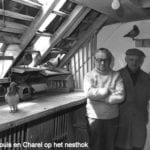
The Janssen Arendonk brothers in the nest box
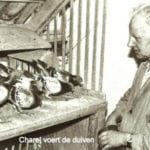
Charel Janssen feeds the nest pigeons
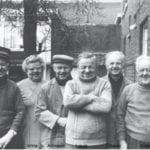
The Janssen Arendonk brothers
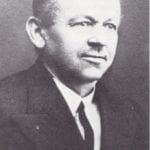
Henri Janssen Arendonk
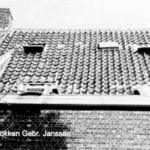
Janssen Loft
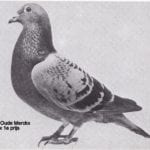
Merckx Gebr. Janssen
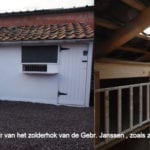
Museum Natural Gebr. Janssen Arendonk
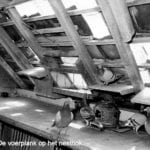
Feeding board in the nest box Gebr. Janssen
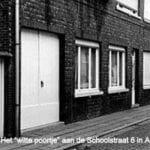
Janssen Arendonk white gate
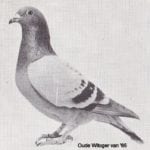
Witoger van 65 Janssen
